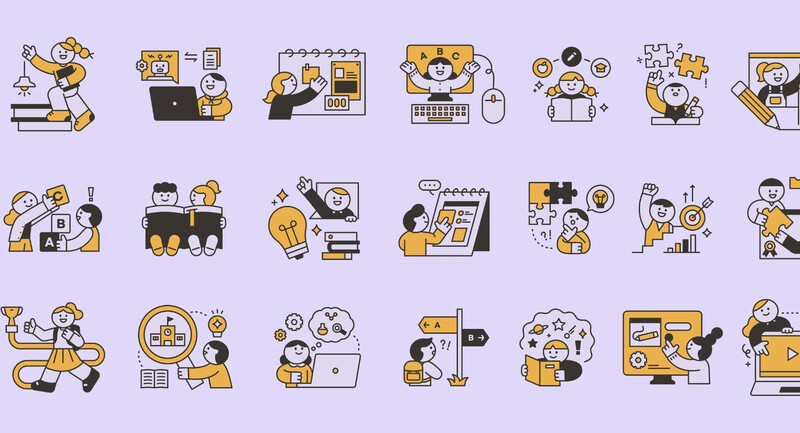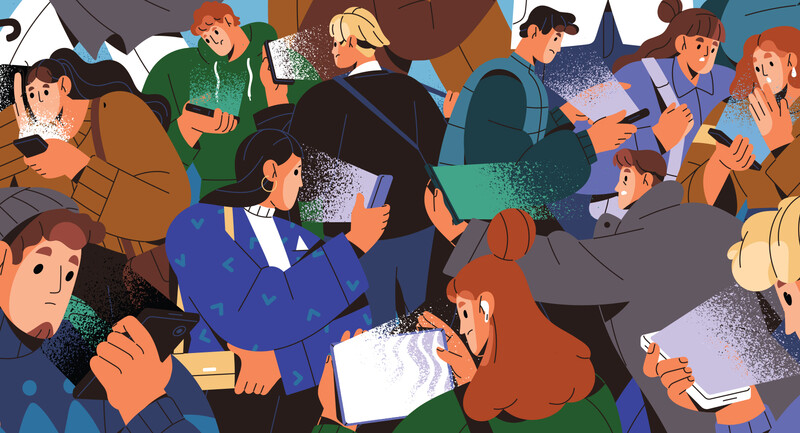When I was growing up, U.S. firms mostly sold their products and services to U.S. consumers and U.S. workers competed with people in the same metro area or region of the state. But in the 1970s, falling prices for transporting manufactured goods made it possible for manufacturers to locate their facilities wherever in the world they could get workers with the necessary skills at the lowest possible cost. At the time, Chinese manufacturing labor cost a hundredth of what it cost in the United States. U.S. companies that didn't send their manufacturing offshore went out of business. U.S. workers who couldn't compete in increasingly global labor markets were in deep trouble.
Before these developments, being ready to work in a manufacturing plant mostly meant being able to do arithmetic and being literate enough to read instructions and write notes for the foreman on the next shift. But the events of the 1970s and those that followed changed everything. The question was not just whether you could do the job responsibly, but whether someone else anywhere in the world could do it as well or better for less money. If someone else could do it better, you could either lower your wages until you beat the competition on the cost of your labor, or you could develop higher skills to add more value to the products and services you produced, thereby justifying your higher wages. There were no other choices.
The Need for Higher-Level Skills
In terms of skills, the data show that U.S. students are performing as well as they always have. But the fact is, that's no longer enough. More than half of high school students aren't ready for high school math, and they write poorly. They read at the 7th or 8th grade level and are unable to comprehend the texts they'll be given in the first year of college or a serious vocational program, even though those texts are written at the 12th grade level (National Center on Education and the Economy, 2013).
This performance is likely no worse than at any time in the last 40 years (National Center for Education Statistics, 2012a). What has changed are the demands of the workplace. Not only that, but the performance of high school students elsewhere has rapidly improved; the typical high school student in more than 15 other industrialized countries now posts scores on international comparative tests that far exceed the performance of the typical U.S. high school student (National Center for Education Statistics, 2012b). The high school graduates in those countries are far more likely to be ready for the modern global workplace than are U.S. students.
Automation: The New Challenge
With outsourcing, when millions of low-skilled jobs went offshore, millions of older American workers didn't have the skills to do the jobs that were left. Some got jobs at much lower wages. Some got low-paying part-time jobs. Some just gave up and stopped working.
Now that manufacturing wages have risen so much in China that they're within striking distance of U.S. wages, manufacturing is, in fact, returning to the United States. But manufacturing jobs are not. That's because more of the actual manufacturing is being done by automated equipment. In China, robots are now replacing millions of manufacturing workers.
So the challenge now is automation, not outsourcing. Robots and other forms of intelligent machinery can do a rapidly growing number of jobs more reliably and at an ever-lower cost than the humans they're replacing. Almost all analysts believe that the economic impact of intelligent machinery will be transformational. According to the McKinsey Global Institute (Economist, 2016), this transformation is "happening 10 times faster and at 300 times the scale, or roughly 3,000 times the impact of the Industrial Revolution."
Experts mainly differ on whether the use of intelligent machines will lead to a general reduction in employment (Ford, 2015), with large numbers of unemployed people receiving permanent income support from the state, or whether a new economy will eventually emerge (Brynjolffson & McAfee, 2014) in which machines will do much of the work now done by humans, but many new jobs will appear. Technologists (Frey & Osborne, 2013) tend to be in the first camp; many economists and economic historians are in the second (Autor, 2015; Economist, 2016; Mokyr, 2014).
Where Humans Can Excel
Whatever their differences, most analysts agree that the impact of these technologies on workers who have only the basic skills is likely to be devastating. Brynjolfsson and McAfee (2014) put it this way:
There's never been a better time to be a worker with special skills or the right education, because these people can use technology to create and capture value. However, there's never been a worse time to be a worker with only the "ordinary" skills and abilities to offer, because computers, robots, and other digital technologies are acquiring these skills and abilities at an extraordinary rate (p. 11).
There will still be work for low-skilled workers, but much less than there has been over the last century or more.
Intelligent machines will create a different kind of working world, one that our students must be prepared for. In this world, which is right around the corner,
A higher proportion of workers will be contingent, independent contractors working an ever-changing array of jobs at the same time for many different employers, with little loyalty of employer to employee or employee to employer.
Employers will have little incentive to invest in developing their employees because their employees might take the skills to another employer overnight.
Technology will advance rapidly, forcing the worker to be on the leading edge of the learning curve all the time.
The ability to learn new things will be at a premium.
The ability to relate to a constantly changing array of people from different backgrounds and with different views and skills will be at a premium.
The ability to work independently with great focus against a tight schedule and make sound judgments on the fly will be crucial.
Workers will be trusted to behave ethically when everyone's back is turned.
Humans will be called on to do the creative and imaginative work that comes much less easily to machines (National Research Council, 2012).
Strong Technical Skills + Deep Learning = Success
Because employers will have weak incentives to train new employees in skills they might sell to another employer, our education system will have to send young people into the labor market with strong technical skills in specialties that will enable them to hit the ground running. But because the jobs for which they trained will be morphing all the time, they'll have to be ready to continually learn.
But that's not all. People who work in professional service firms will need to serve as one-stop shops for clients who don't want to be shifted from department to department; they'll need to be well versed in the jobs of many people. The worker who's not continually learning—indeed, who's not on top of the state-of-the-art knowledge in many fields at once—will be behind the eight ball.
Giving all students strong technical skills in a specialty area is a challenge we rarely meet. Enabling all students to engage in deep learning is another challenge we rarely meet. We have to do both, all the time, for all our students—and that's a tall order. Here are some actions schools can take to tackle this work.
Focus on continuous learning
Preparing students for a life of continuous learning is a much researched subject (Bransford, Brown, & Cocking, 1999), but I'd like to highlight some key points here.
Knowledge isn't simply transferred from the page or the lecture to storage in the student's brain. Knowledge is constructed in that brain as the student gets new input. The way it's constructed depends on both what the student already knows and how that new knowledge is presented and used. Learning new things is more fruitful if the student brings to that task deep knowledge of the underlying concepts in fields related to the things he or she is trying to learn.
Skills like synthesis and analysis are important, but they can't be learned in the abstract, nor do they transfer readily from one body of knowledge to another. Being able to analyze and synthesize will require students to know a lot about the material they're analyzing and synthesizing. It's simply not true that the profusion of knowledge in recent years makes the accumulation of knowledge unnecessary. Students have to know a lot—and that knowledge needs to be deep, not shallow. One of the richest sources of creativity is the ability to use the conceptual structures developed in one field to look at another field, seeing it through another set of eyeglasses.
Integrate academic and technical learning
We've lived for a long time in a world in which there's a sharp divide between high-status learning, in which we take a dry-as-dust course in order to take the next dry-as-dust course and so on, and career and technical education, which we've long treated as fit only for students who aren't good at academics. We'll have to abandon that model if we're to prepare our students for their lives beyond school. The curriculum that students need must create a constant interplay between academics and application; problems that arise in the course of application give rise to the questions addressed in the academics, and the constructs learned in the academics are explored in application.
The pieces of this curriculum lie all around us. But beware. Much project-based learning is tied to shallow academics. Sometimes a school will offer a year-long course on the geology, hydraulics, and industrial development of the local river and the politics, sociology, and economics of the communities that developed along its banks, but the teacher doesn't know much more than her students about any of these things, so the course never gets beyond what the students can find on Wikipedia. Too much of our academics consists of drill and practice in surface knowledge and rote procedures that intelligent devices do far better than humans. If your students are going to be adults for whom intelligent devices are servants rather than masters, their academic learning will have to go far deeper and their applied learning will have to be much less superficial than much of what I see in our schools today.
When students enter the workforce, they must have both a strong general education and strong technical preparation in a particular field. Students going on to postsecondary education will probably get that technical preparation in college or graduate school. Those who don't will need to get that preparation before they graduate from high school. Singapore and Switzerland are far ahead of the United States in constructing systems for career and vocational education that give high school seniors the kind of strong technical skills they'll need (Hoffman & Schwartz, 2015; Tucker, 2012).
Offer experiences that teach a range of habits and skills
But students need more than just the cognitive challenge that the formal curriculum offers.
They must develop a full range of qualities, many of which are related to character. Schools should create experiences for students in and out of school that will enable them to develop the full range of habits, values, ethical commitments, skills, and knowledge they need (Education 2.1, 2016; Tucker, 2016). In this formulation—one in which schooling becomes a carefully orchestrated set of experiences for students—the sports program is no less important than the mathematics classes, the week on the wild river with 10 classmates is no less important than the literature classes, and apprenticing in an advanced manufacturing facility is no less important than attending the advanced placement physics class.
In this conception of school, the faculty's job is not just to offer classes and volunteer to coach a sport. Rather, it's to collectively plan a set of experiences for the entire student body that will engage every student. This will require the faculty, acting as a whole, to agree on the full range of cognitive and noncognitive qualities they want their students to have when they leave school and also come to agreement on the experiences that the school will offer all students that will enable them to acquire these qualities. At the same time, a particular member of the faculty would be responsible for the development of each student in a process owned by the entire faculty.
Create a school vision of what the prepared student looks like
A shared conception among the faculty of what a prepared student looks like would take into account the following:
What it means to do the right thing when no one is watching.
What deep learning is and how to produce and assess it.
What it means to work independently against deadlines and meet them with high standards of quality.
How to know when a student is a strong contributor as a team member.
How the school will structure opportunities for leadership so all students get a chance to lead.
Some people call these 21st century skills. But most of these skills were valued by the ancient Greeks and all of them by the masters of the British Empire. We used to think that ordinary workers didn't need them, so they were only taught to the elites. But now, given the skills we need, we must treat all our students as elites.
What Does Global-Ready Really Mean?
This is what it will take to prepare students for a world in which global economic forces and advancing technology are acting together to dramatically change the demands on both graduates and their teachers. But for many people, globally ready means something far more specific—namely, being fluent in languages other than English and being aware of and open to the perspectives of people in other parts of the world.
As far as fluency in other languages is concerned, a large portion of the world's professionals now speak English. More to the point, you may work for an employer who assigns you to work in another country. However, you have no way of knowing which country that will be when you're in school, and the likelihood that the language you choose to study will be the language you need is small indeed. You'll usually find that your employer will be more than willing to pay for you to learn the language you'll need.
The language issue aside, it's far more important for Americans to understand the perspectives of people from other parts of the world. Whether our future graduates will be selling to people in other countries, buying from them, building teams with them, or simply voting on issues that arise from our conflicts and alliances with other countries, it's essential that we Americans know much more than we currently do about people whose cultures are different from our own.
If I were to create a curriculum, I would divide the world into regions and require all students to take one full-year course introducing them to the achievements, aspirations, outlook, conflicts, and sorrows of the people of one of those regions. I would design these courses to enable students to see the world as the people from their selected region see it, through the lens of their history, literature, music, economic development, politics, wars, religious commitments, and geography. This information would be presented not as an endless catalogue like an encyclopedia, but as the living story of real people who occupy the same globe that we do.
The forces I've described are creating winners and losers on a grand scale. Let's ensure that U.S. students are firmly among the winners. Let's ensure that we produce highly educated young people with strong technical skills, a strong character, good communications skills, a well-developed ethical frame, and the ability to relate well to a wide range of people from all over the world. Our success as a nation depends on it.









